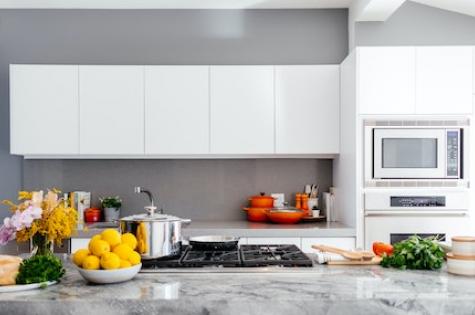Renovating your kitchen and bathroom can be an exciting process, but it can also have a negative impact on the environment. However, with the growing concern about climate change, homeowners are now turning to eco-friendly kitchen and bathroom renovations to reduce their carbon footprint and create a healthier living space. In this blog, we will provide tips on how to make your kitchen and bathroom renovations more eco-friendly, with a focus on using sustainable materials, energy-efficient appliances, and water-saving fixtures.
Sustainable Materials for Kitchen and Bathroom Renovations
One of the most significant ways to make your kitchen and bathroom renovations eco-friendly is to use sustainable materials. Sustainable materials are made from renewable or recycled sources, and they can help reduce the amount of waste in landfills. Some examples of sustainable materials include bamboo, cork, recycled glass, and reclaimed wood. Here are our top 3:
Bamboo
An excellent choice for flooring and cabinets because it is durable, lightweight, and easy to maintain. Cork is another eco-friendly material that can be used for flooring, countertops, and walls. It is a sustainable option because it is harvested from the bark of cork trees, which regenerates every nine years.
Recycled glass
An eco-friendly material that can be used for countertops and backsplashes. It is made from recycled glass bottles and has a unique look that can add character to any kitchen or bathroom.
Reclaimed wood
Another sustainable material that can be used for flooring, cabinets, and accent walls. It is sourced from old buildings, barns, or pallets, and repurposed to create a new look.
Energy-Efficient Appliances
Another way to make your kitchen and bathroom renovations eco-friendly is by using energy-efficient appliances. These appliances are designed to use less energy than traditional appliances, which helps reduce greenhouse gas emissions and lower your utility bills. Some examples of energy-efficient appliances include dishwashers, refrigerators, and washing machines.
When choosing energy-efficient appliances, look for products with the Energy Star label. The Energy Star program is a government-backed initiative that certifies products that meet certain energy efficiency standards, ensuring that they use less energy and are more environmentally friendly than their non-certified counterparts. Choosing Energy Star appliances for your kitchen and bathroom renovation can help you save money on your energy bill while reducing your carbon footprint.
Water-Saving Fixtures
Water-saving fixtures use less water without sacrificing performance, saving you money on your water bill while also conserving this vital resource.
Benefits of using water-saving fixtures
Using water-saving fixtures in your kitchen and bathroom renovation has numerous benefits. Firstly, it helps conserve water, which is becoming increasingly important as we face more droughts and water shortages. Secondly, water-saving fixtures can save you money on your water bill, as you'll be using less water overall. Thirdly, they often have a longer lifespan than traditional fixtures, meaning you'll save money on replacement costs in the long run.
Examples of water-saving fixtures for kitchens and bathrooms
There are several types of water-saving fixtures to consider when renovating your kitchen or bathroom. Low-flow faucets and showerheads are a popular choice, as they restrict the amount of water flowing through them without affecting water pressure. Dual-flush toilets are also a great option, allowing you to choose between a lower or higher volume of water depending on the waste being flushed. Lastly, aerators can be added to your existing faucets to reduce the flow of water while maintaining good pressure.
Tips for Planning an Eco-Friendly Kitchen and Bathroom Renovation
When planning an eco-friendly kitchen or bathroom renovation, it's important to consider all aspects of the project. Here are some tips for incorporating sustainable practices into your renovation plans:
-
Think about the materials you'll be using, the energy efficiency of your appliances, and the water-saving features of your fixtures. Consider the long-term impact of your choices, such as the durability and environmental impact of your materials and the energy efficiency of your appliances.
-
Choose materials that are sustainable, such as bamboo or recycled glass. Look for appliances that are Energy Star certified, meaning they use less energy and are more efficient. Select water-saving fixtures, such as low-flow faucets, showerheads, and toilets, to conserve water.
-
There are many resources available for finding eco-friendly products for your renovation project. Look for products with certifications such as LEED (Leadership in Energy and Environmental Design) or the Forest Stewardship Council (FSC) to ensure they meet certain sustainability standards. Additionally, there are many online retailers that specialize in eco-friendly home goods and building materials.
Conclusion
Incorporating water-saving fixtures into your kitchen and bathroom renovation plans is an important step towards creating a more sustainable home. By considering all aspects of your renovation project, such as materials, appliances, and fixtures, you can create a space that is both beautiful and eco-friendly. Make the commitment to sustainable practices today and enjoy the benefits for years to come.















__small.png)










